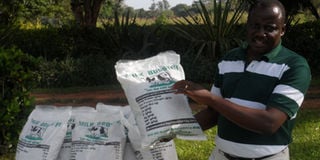A supplement to boost milk production in cattle

Dr Fred Kabi displays a bag of the milk booster, which comes standard in 5kg packaging. Photo by Esther Oluka.
Agricultural productivity can make the difference between a better life or extreme hunger and poverty. Therefore, an approach which considers crops, livestock and agro-processing industries as different activities without them being linked will lead to low agricultural productivity in Uganda.
With this in mind, researchers at Makerere University undertook a project to convert molasses into a low-cost dairy supplement called milk booster.
Most farmers will agree that the more milk a cow produces, the better the income. Therefore what the majority of farmers resort to especially during the dry season when there is scarcity of pasture is supplements.
How it works
One such supplement is the milk booster. It is in form of pellets; loaded with sufficient nutrients for the cow and is also meant to boost the growth of microbial bacteria within the stomach of the cow.
Once these microbes grow very well in the rumen of the animal, they will produce enzymes that eventually improve on the digestion; especially of fibrous feeds during dry seasons when feeds such as elephant grass and other pastures are more fibrous.
These supplements break down the feeds given to the cows to increase its milk output.
High demand
Studies conducted by the project showed that 1kg of the supplement increased milk production by over 30 per cent during the dry season in Jinja, Iganga, Kamuli, Mayuge and Mukono Districts, where the innovation was tested.
The supplement was therefore branded “milk booster” and due to its high demand, the product was launched for commercialisation during July 2012 National Agricultural Show held in Jinja. It is a win-win situation for the dairy industry, especially dairy farmers who needed to boost their milk production.
The milk booster is made out of sugarcane molasses mixed with urea, mineral salts, lime, cotton seed cake and maize bran. It is also fortified with essential amino acids necessary for improving on the growth of mammary gland cells that produce milk. This means, the booster can also be fed to cow possibly two months before delivery.
Dr. Fred Kabi, a livestock nutritionist and a senior lecturer at the College of Agricultural and environmental Sciences, Makerere University, says that the idea of making the supplement came up because there was need to solve the challenge of feed scarcity especially during the dry season as well as poor milk productivity amongst zero-grazing farmers.
“This scientific innovation is therefore meant to boost milk production in dairy cattle in order to beat extreme hunger and poverty in the country,” Kabi says.
The supplement is mainly effective during the dry season because around this time the quality of feeds is poor making the supply of milk to be very low as a result of the poor diet that the animals usually have.
It is, however, at this time when the prices of milk also go high and the farmers miss out on the income that would otherwise flow into their pockets.
The innovation of the milk booster ensures that the dairy farmer is able to improve on the milk yield or at least maintain it when the prices of milk is highest.
Since the milk boost is composed of lots nitrogen including non-protein nitrogen, Kabi says that it is crucial that the animal is constantly given water to take enable better removal of the excreta in form of urea.
If enough water is not provided, then the water that is otherwise meant for milk production will be used in the elimination of poisonous urea excreta.
Challenges encountered in making the feed
According to Kabi, the ingredients including high quality maize bran which is one of the vital raw materials used in making the supplement is expensive and the prices vary depending on availability. The export of unprocessed whole maize to neighbouring countries is responsible for the high prices of maize bran, Kabi observes.
“The production team spends a lot of money monthly just for buying that maize bran, molasses and the other ingredients,” he says.
Other than the expenses, the other big challenge faced is in understanding the dynamics of market given that most of the time has to be portioned towards further research and training
“There are many technical processes and people involved in making this product but understanding the market seems more important. Therefore one has to constantly be acquainted with science as well as entrepreneurship at all times,” he says.
Where to get the product
Jinja, Mukono and Gayaza are main distribution points for the product. Each bag weighs 5kgs and costs Shs10,000. At the moment Kabi says that production is being done at the backyard of his home but in the near future, he hopes to establish a fully fledged and permanent industrialised facility where all the processing will be done.
Also, he hopes that he will come up with an industrial park based on well researched knowledge to address all the challenges in cattle production by establishing the Bovine Booster Business Park (BBB-Park), that will address all the nutritional needs of not only dairy cattle but also calves, heifers and beef cattle.




